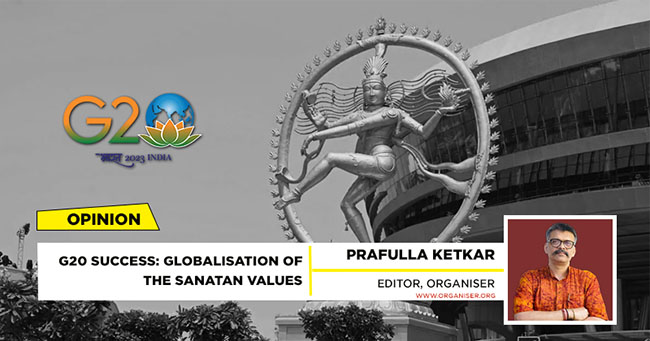“World peace is in fact our ultimate goal. It has been our nation’s life mission, and we have to fulfil it. To give lessons in peace to the world on a spiritual level and to create a sense of oneness in the whole of humanity has been our real national mission since ages. But when will all this become possible? Only when we succeed in bringing together crores of our own people and imbuing them with our sublime cultural values and sterling character and motivating them for the achievement of that mission.” – Shri Guruji (M S Golwarkar) – Pioneer of A New Era, C. P. Bhishikar, translated into English by Sudhakar Raje, Sahintya Sindhu Prakashan Banglore, P. 81
The G20 Summit is generally an elite forum marred by a few protests. Though last year’s summit in Indonesia was relatively peaceful, earlier editions of the global negotiations on economic policies remained in the news for protests and violence, mainly by the Communist-leaning, anti-globalisation groups focusing on environmental protection and labour laws. The 2010 G20 Summit in Canada witnessed the most violent episodes, and the Hamburg Summit protests of 2017 are still afresh in the memory of Germans. Against this backdrop, Bharat did not just conduct a peaceful and fruitful summit but celebrated it like a national festival. There were forces within and outside Bharat who tried their best for the failure of Bharat’s rotational presidency tenure. Bharat defied all that and ensured a consensus in finalising the Delhi Declaration. Delhi residents, by and large, accepted the inconvenience caused due to the traffic restrictions as a national cause. Why could Bharat achieve such a glorious feat, posing a new challenge for the hosts of future G20 presidencies?
The dynamic and decisive leadership of Prime Minister Narendra Modi is the foremost reason behind the success. His innovative approach and economic and strategic resurgence of Bharat allowed the G20 presidency to be more inclusive and impactful. His team systematically built momentum throughout the year towards the summit. Modi’s rapport with the individual leaders proved to be handy in bridging the contentious viewpoints. Barring Chinese President Xi Jinping, everyone responded positively. The inclusion of the African Union on the main table of negotiations was PM Modi’s sole initiative. The inclusive approach is reflected on the domestic front also. Besides the regular Sherpa and economic tracks, engagement like Civil20 to Labour20 ensured the participation of various stakeholders in the elite-looking platform. If the leadership is ready to lead by example, then inclusive and participatory outcomes are possible; PM Modi exhibited the same clinically.
The previous summits witnessed the protests on the Global South plank. Bharat represented those sentiments along with Brazil and South Africa. The Delhi Declaration has a strong imprint of the sustainable development agenda, human-centric approach, smooth energy transition and need to reform the multilateral institutions. The protest brigade of Communists, who do not have any constructive alternatives except the Chinese model of State capitalism, lost the ground to instigate violence amidst the absence of issues. Bharat proved to be a bridge builder between the developed and developing world.
The most important reason behind this prolific Presidency of Bharat is the way we presented ourselves to the world. Traditionally, under the influence of colonial baggage and Nehruvian socialism, Bharat shied away from its civilisational wisdom. To be ‘modern’ and ‘progressive’, Bharat tried to present what it was not. During the G20 Presidency, with the Vasudhaiva Kutumbakam as the core theme, Bharat reconnected with the civilisational ethos and recontextualised it for the contemporary world. Instead of imitating the Western templates, Bharat sought to present the universal essence of the familial globalisation that Sanatan Dharma teaches. Throughout the Presidency, the cultural unity of Bharat was exhibited to the world while celebrating diversity. Bharat’s unique knowledge system enables us to experience ‘unity in diversity’ and to establish ‘unity amongst variety’ — the inherent Dharma (the spirit) of Bharat – as explained by Gurudev Rabindranath Tagore. Bharat Mandapam with the Nataraj at the entrance, Konark Sun Temple and Nalanda ruins as the background landscapes and the Mother of Democracy exhibition – all represented the time and space antiquities enshrined in the Bharatiya knowledge tradition. That conviction and confidence about the ancient and eternal (Sanatan) Bharat allowed the G20 Summit in Delhi to build a consensus on all the intricate issues, including the Ukraine War.
As envisaged by stalwarts like Swami Vivekananda, Sri Aurobindo, and Shri Guruji Golwalkar, the life mission of Bharat is to provide solutions for world peace. Let us hope that the G20 Summit gives us new confidence and energy to work together to realise the civilisational goal of Bharat to attain the pinnacle of glory for the harmonious and prosperous world.




















Comments